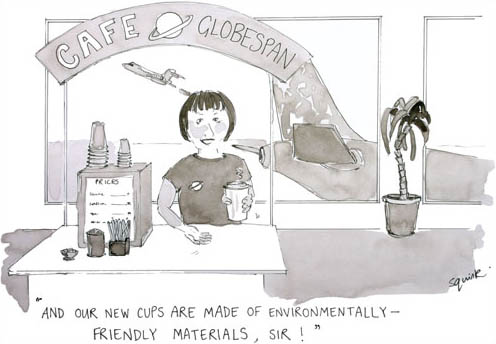5.5 Reaction to the Aviation White Paper
The immediate reaction by the aviation industry was highly favourable. It was clearly apparent that almost all of the demands of the aviation industry had been met. Andrew Cahn, British Airways director of government affairs, was quoted in the 17 December 2003 issue of The Guardian newspaper as saying: ‘I have to say, we’re pretty delighted ’.
On the other hand the majority of the organisations representing environmental perspectives accused the government of abdicating its environmental responsibilities. The climate change targets for reduction in greenhouse gas emissions were not tackled at all while the procedures for payments of environmental impacts were left unclear. Who, for example, was going to get the 5p per passenger per flight for the noise impacts? How was the £20 levy on ticket prices going to cover the permanent climate change damage of greenhouse gas emissions?
Activity 24 Critique of the white paper
Listen to the audio programme titled Critique of the white paper. This includes the Department for Transport’s account of the final decision and a critique from Peter Ainsworth MP and Richard Dyer of Friends of the Earth.
Transcript: Critique of the white paper (23 minutes 28 seconds)
Critique of the white paper
BBC Today 08/06/04
Drawing on the Critique of the white paper programme and the rest of the case study material, review the decision-making process of the Aviation White Paper and the context within which it evolved.
- Who were the decision makers? How did they arrive at their position of decision making? Which resources did they control? Which values underpinned their actions?
- What was the decision situation? What was the context? What were the uncertainties? What actual and potential risks were involved?
- What problems were posed by the decision makers? Which opportunities were apparent to them?
- Which criteria did the decision makers adopt to structure the decision-making process?
- Within which time-frame did the decision-making process occur, and what sequence did the various components take?
- Who were the people affected by the decision? How was their participation in the decision-making process managed?
- What kinds of decision support (theories, tools and techniques) were in evidence in the Aviation White Paper decision-making process?
Discussion
- Alistair Darling, the then Minister of Transport, was clearly the person with the final say in the Aviation White Paper. His mandate to govern as Minister for Transport was awarded to him by Tony Blair, the then Prime Minister. The whole Aviation White Paper process was, in fact, underpinned by a series of decisions, such as the assumptions within the SPASM modelling, and yet the principal decision makers within the Department for Transport seem to have had a strong role in selecting outcomes which favoured airport expansion and significant resources were available.
- The decision situation was certainly complex. Decision makers started in an environment where very little was known and studies needed to be initiated to provide quick results on predicted capacity and social, economic and environmental impacts. The decision makers had to balance local national interests and international obligations (chiefly as climate change), stakeholders from industry, the environmental movement and local residents, short-term gains and long-term impacts. The latter were highly uncertain, ranging from predicated capacity needs to socio-economic benefits to environmental effects. At risk were principally short-term political careers, competitiveness of UK aviation-related business and, in the long term, people’s health.
- The problems posed by the decision makers from the initial lack of an airport expansion strategy included loss of competitiveness of the UK aviation industry with capacity taken up in mainland Europe, and the risk of a protracted and costly public inquiry on submission of a development proposal. The opportunities included developing a clear strategy for expansion that supposed balanced social, economic and environmental impacts. I actually think that the decision makers saw environmental impacts as a minor concern, with the notion of ‘develop now, clean up later’ (preferably by someone in the next generation) firmly in their minds. Resolving the environmental impact of aviation was therefore seen as an opportunity.
- The rhetoric in the Aviation White Paper process was very much based around balancing socio-economic benefits and environmental impacts. One of the main criteria used was monetary valuation, i.e. that social, economic and environmental issues could be costed and compared so as to support decision making. Interested parties were consulted but there was no participation in determining the decision-making process and, indeed, the criteria which actually resulted in the final decision are unknown since deliberations were carried out behind closed doors.
- The Aviation White Paper process occurred over the 2000–03 time period when major worldwide events were taking place which could have significantly affected the development (the 11 September 2001 terrorist attacks, the Kyoto Protocol on climate change, preparation for war in Iraq, etc.). Yet the process did not seem to have adapted to the evolving worldwide situation.
- The people involved can be divided into those under the direct influence of the decision – the travelling public, the aviation industry and related businesses, the residents surrounding airports, the environmental movement, and the various governing bodies (DfT, local councils, etc.); those under indirect influence – the taxpayer (through subsidies to the aviation industry); and those potentially affected by aviation’s contribution to climate change.
- Mathematical modelling to predict capacity requirements played a key role in the decision-making process. Cost–benefit analysis was also a significant technique used. Other techniques used included mapping, questionnaires and a wide range of environmental sampling techniques at the sites proposed for development.

